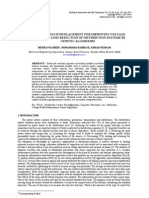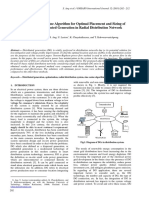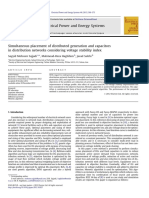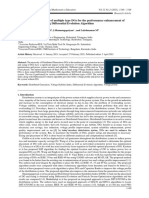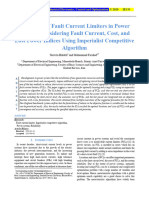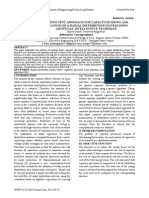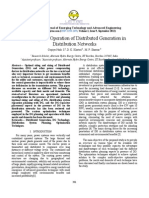ACO Based Algorithm For Distributed Generation Sources Allocation and Sizing in Distribution Systems
ACO Based Algorithm For Distributed Generation Sources Allocation and Sizing in Distribution Systems
Uploaded by
Pervez AhmadCopyright:
Available Formats
ACO Based Algorithm For Distributed Generation Sources Allocation and Sizing in Distribution Systems
ACO Based Algorithm For Distributed Generation Sources Allocation and Sizing in Distribution Systems
Uploaded by
Pervez AhmadOriginal Title
Copyright
Available Formats
Share this document
Did you find this document useful?
Is this content inappropriate?
Copyright:
Available Formats
ACO Based Algorithm For Distributed Generation Sources Allocation and Sizing in Distribution Systems
ACO Based Algorithm For Distributed Generation Sources Allocation and Sizing in Distribution Systems
Uploaded by
Pervez AhmadCopyright:
Available Formats
559 1
Abstract Distributed generation (DG) placement is
addressed in this paper. A cost based model to find the optimal
size and location of distributed generation sources in a power
distribution system is proposed in which the objective is defined
as minimization of DG investment cost and total operation cost of
the system. The proposed objective function and its constraints
form an optimization problem which is solved using ant colony
optimization (ACO) as the optimization tool. Application
example is presented to demonstrate the effectiveness of the
proposed methodology.
Index Terms Distributed Generation, Distribution System
Optimal Placement, Sizing, Ant Colony Optimization (ACO).
I. INTRODUCTION
OWER system restructuring, technology progress, and
tight constraints over the construction of new bulk
substation and transmission lines have created increased
interest in distributed generation (DG) as an alternative for
supplying electric power to customers. DGs are smaller plant
connected to the distribution systems. Distributed generation
sources can be strategically allocated in distribution systems
for reducing power losses, network reinforcement, improving
system efficiency and reliability. Determining proper capacity
and location of DG sources in distribution systems is
important for obtaining their maximum potential benefits.
In recent years several studies consider techniques for locating
DG units on distribution feeders for optimal benefit [1]-[16].
Methods and procedures of the DG placement are varied
according to objective and the problem solution viewpoints.
In [1], Rau and Wan employ gradient and second order
methods to determine the optimal DG location for the
minimization loss, line loading and reactive power
requirement in the network. Kim et al in [2] suggest a
combination of fuzzy non-linear goal programming and
genetic algorithm techniques to locate DGs and minimize
overall power losses. In [3], Nara et al apply Tabu search
method to the same problem. Griffin et al in [4] demonstrate
an iterative method that provides an approximation for the
optimal placement of DGs for loss minimization. In [5], Kim
et al apply Hereford ranch algorithm to optimal placement of
fixed capacity DG in order to minimize the losses of network.
Celli et al in [6] propose a multi-objective formulation for the
The authors are with the Department of Electrical Engineering, Tarbiat
Modarres University, Tehran, P O Box 14115-111, Iran (e-mails:
falaghi@modares.ac.ir, haghifam@modares.ac.ir).
sizing and sitting of DG units into distribution feeders for
simultaneous minimization of cost of network upgrading,
losses, energy not supplied and customer energy. Willis in [7]
offers a "2/3 rule" to place DG on a radial feeder with
uniformly distributed load, where it is suggested to install DG
of approximately 2/3 capacity of the incoming generation at
approximately 2/3 of the length of line. El-Khattam et al in [8]
use a heuristic approach to determine the optimal DG size and
location in distribution feeders from an investment point of
view. Wang and Nehrir in [9] present analytical approaches
for determining optimal location of DG units with unity power
factor in power system to minimize the power losses. In [10],
Harrison and Wallace employ an optimal power flow
technique to maximize DG capacity with respect to voltage
and thermal constraints. Popovic et al in [11] use a sensitivity
analysis to maximize DG capacity in the network without
violation of security constraints. Keane and O'Malley in [12]
present a method based on linear programming to determine
the optimal allocation of DG with respect to technical
constraints. In [13] Carpenellis et al propose a methodology
based on multi-objective programming and decision theory
which to find the best development plan for the system by
using the DG as a development option. In [14], Borges and
Falcao propose a methodology for optimal DG allocation and
sizing in order to minimize the network losses and to
guaranteeing acceptable reliability level and voltage profile. In
the literatures, several optimization techniques have been
applied to DG placement, such as genetic algorithm [2, 6, 13,
14], tabu search [3], heuristic algorithms [4, 8] and analytical
based methods [1, 7, 9].
This paper presents a model to determine optimal location
and size of DGs in a distribution system which is solved using
ant colony optimization (ACO) as the optimization tool. In
this algorithm DGs are considered as constant power sources
such as fuel cells. Therefore, distribution system operator can
only turn on or off the DG sources and can not change their
power productions.
In the following sections, problem formulation is presented
in Section II, implementation of ACO method is explained in
section III and a case study is reported in section IV. Finally,
the conclusions of the paper are summarized in Section V.
II. PROBLEM FORMULATION
In the proposed objective function for distributed generation
sources allocation and sizing following items are considered:
ACO Based Algorithm for Distributed Generation
Sources Allocation and Sizing in Distribution Systems
Hamid Falaghi, Student Member, IEEE, and Mahmood-Reza Haghifam, Senior Member, IEEE
P
559 2
Investment cost of DG sources
Operation and maintenance cost of DG sources
Cost of Energy Buying from transmission grid
Cost of losses
The objective function can be formulated as following
equation:
= = =
= = =
=
+
+ =
nyr
y
nss
j
nld
l
l SSl l SSj
y
nyr
y
ncd
i
nld
l
l EDG l i
y
ncd
i
IDG DGi
T K P PW
T K C PW
K C Z
1 1 1
,
1 1 1
,
1
Min
(1)
} { max
,
,..., 2 , 1
l i
nld l
DGi
C C
=
=
(2)
IntR
InfR
PW
+
+
=
1
1
(3)
where,
Z: Value of objective function ($)
ncd: Number of candidate site for DG placement in the
network
nld: Number of load level in year
nss: Number of HV/MV substation in the system
nyr: Planning period (year)
C
DGi
: Selected capacity of DG for installation in node i
(MVA)
K
IDG
: Investment cost of DG sources ($/MVA)
K
EDG
: Operation cost of DG sources including maintenance
cost ($/MWh)
K
SSl
: Energy market price in load level l ($/MWh)
P
SSj,l
: Power dispatched from substation j at load level l
including network losses (MW)
C
i,l
: Generated power by DG source installed in node i at
load level l (MW)
PW: Present worth factor
IntR: The interest rate
InfR: The inflation rate
The objective function (1) is minimized subject to a set of
constraints as below.
Capacities of the feeder sections:
The power transported by each feeder sections over the year
must be equal or less than thermal capacity of its conductor.
max i l i
I I
, ,
s (4)
where, I
i,l
and I
i,max
are load flow and thermal limits of line
section i.
Voltage magnitude limit:
The modified backward/forward distribution load flow
algorithm [15] is used for the evaluation of the behavior of the
system. Once the node voltages have been calculated, the
following expression is used for the evaluation of the
correspondent constraint:
max l i min
V V V s s
,
(5)
where, V
i,l
is calculated voltage magnitude at the ith node
during load level l. V
min
and V
max
are Maximum and minimum
allowed operation voltage.
Total DG capacity limitation:
This constraint limits total capacity of DG units to be installed
in the distribution system (due to any practical/financial
limitations). Therefore
max DG
ncd
i
DGi
C C
,
1
s
=
(6)
where, C
DGi
is selected DG capacity at the ith candidate site.
C
DGi
is total allowed capacity of DG sources that can be
installed in the system
The developed problem is constrained, nonlinear model,
with integer variables (due to the discrete size of DG units). In
the proposed algorithm optimal location and size of DG
sources search along candidate nodes of distribution system
using ACO as described i the next Section.
III. ANT COLONY OPTIMIZATION (ACO)
A. General Aspects
The general ACO algorithm derived from the behavior of
real ants is illustrated in Fig. 1. The procedure of the ACO
algorithm manages the scheduling of three activities [16],
[17]: The first step consists mainly in the initialization of the
pheromone trail. In the iteration (second) step, each ant
constructs a complete solution to the problem according to a
probabilistic state transition rule. The state transition rule
depends mainly on the state of the pheromone. The third step
updates quantity of pheromone; a pheromone updating rule is
applied in two phases. First is an evaporation phase where a
fraction of the pheromone evaporates, and then there is a
reinforcement phase increasing amount of pheromone on path
with high quality solutions. This process is iterated until a
stopping criterion is reached.
Fig. 1. A generic ACO algorithm.
Several different ways have been proposed to translate the
above principles into a computational procedure to solve the
optimization problem. The optimization approach proposed
for in this paper is based on the ACO algorithm presented in
[18] and outlined in the next subsection.
B. Applying ACO to DG Placement Problem
Main steps of proposed ACO algorithm are listed below:
Step1) Graph representation of search space
First of all, we seek to devise a representation structure that
is suitable for ants to search for solutions to the problem. The
searching space of the problem is shown in Fig. 2.
559 3
Fig. 2. Searching space of the problem.
All possible candidate capacity values in site n are
represented by the states in the searching space in
correspondence to stage n. The number of stages for each load
level is equal to the number of candidate nodes of distribution
system for DG placement. So, total number of stages is equal
to ( ncd nld ). A solution to the problem is produced after an
ant completes its decision process for the sub-paths forming a
tour.
Step2) ACO initialization
In the beginning of ACO algorithm, the pheromone values
of edges in search space are all initialized to a constant value
N
0
> 0. This initialization causes ants choose their paths
randomly and therefore, search the solution space more
effectively.
Step3) Ant dispatch
In this step, the ants are dispatched and solutions are
constructed based on the level of pheromone on edges. Each
ant will start its tour at the home colony and choose one of the
states in the next stage to move according to following
transition probability.
A e
=
i
h
ij
ij
ij
t
t
t P
)] ( [
)] ( [
) (
t
t
(7)
where, /
ij
(t) is the total pheromone deposited on edge ij at
iteration t, and P
i
represents the set of available edges which
ant can choose at state i.
After each ant ends its tour, a new solution for DG
placement is generated which must be evaluated using fitness
function.
Step4) Fitness function
In this step, the fitness of tours generated by ants is assessed
based on fitness function. The fitness function of the problem
is defined as the inverse of the total cost (1) plus a penalty
factor to the infeasible solutions (i.e., the ones violating the
constraints). To speed up the convergence properties of
algorithm and at the same time, to use the information that
may still be useful in rejected tours, this penalty factor is
linearly increased (through iterations) from zero toward a very
high value.
Step5) Pheromone update
The aim of the pheromone value update rule is to increase
the pheromone values on solution components that have been
found in high fitness solutions. Also, from a practical point of
view, pheromone evaporation is needed to avoid a too rapid
convergence of the algorithm toward a sub-optimal region. It
implements a useful form of forgetting, favoring the
exploration of new areas in the search space. We use the
following update rule in our study [18].
{ }
{ }
O e
O +
= +
,
, ) ( ), ( ) 1 ( max
), ( ) , (
, ) ( )), ( ( ) ( ) 1 ( max
) 1 (
min
min
otherwise
t t
t j i if
t t F Q t
t
ij
B
B ij
ij
t t
t t
t (8)
where, 0 < 5 <1 is pheromone evaporation rate. R
B
(t) is the
best tour found until the end of iteration t, which is stored in a
specific list variable and replaced each time some ant finds a
tour with better quality function value. F(R
B
(t)) is the quality
function value corresponding to R
B
(t). Q is a heuristic variable
which control amount of pheromone addition on the best tour.
/
min
(t) is lower bound of pheromone which results in a small
probability for an ant to choose a certain edge; still the
probability will be greater than zero. This lower bound is a
function of the iteration counter as bellow:
) 1 ( ) (
max
min min
t
t
t =t t
(9)
where, /
min
is initial lower bound of pheromone.
Step6) Convergence determination
The steps 3-5 continue until the iteration counter reaches the
predefined maximum number which determines
experimentally. The best tour selected among all iterations
implies the optimal DG placement solution.
Fig. 3 shows the flowchart of the proposed ACO-based
solution techniques.
Fig. 3. Flowchart of the proposed ACO-based solution techniques.
559 4
IV. CASE STUDY
Based on the proposed algorithm, software was developed
using MATLAB programming language for DG sources
placement and sizing in distribution systems. The proposed
method was tested on a several distribution system by use of
prepared software with satisfactory results. Result of DG
placement in a typical distribution system studied in [19] is
reported in the paper. This distribution system shown in Fig. 4
consists of one 132-kV/33-kV substation of 40 MVA capacity
to serve eight aggregated loads. Technical characteristics of
conductors used in line segments and peak load data are given
in Tables I. Power factor of all loads is 0.9. All system nodes
except substation node are considered as candidate sites for
DG placement. Power factor for all loads is 0.95. The
candidate DGs have sizes of multiples of 1 MVA (maximum 4
MW) with power generation at unity load factor. Total
allowed capacity of DG sources that can be installed in the
system is 20 MVA. Table II shows load and market price data
used in the case studies. In this table different loading levels of
the system are modeled as percentage of the peak load. Cost
data is listed in Table III. Allowable voltage deviation for all
nodes is considered as % 5 = AV .
Fig. 4. Distribution system under study.
TABLE I
TECHNICAL CHARACTERISTICS OF CONDUCTORS AND PEAK LOAD DATA
OF THE DISTRIBUTION SYSTEM
Section
From To
R
(R)
X
(R)
Thermal Limit
(Amp.)
Peak Load at
To node
(MVA)
1 3 1.390 2.255 210 8.404
3 7 2.780 4.510 210 9.592
1 2 2.085 3.383 210 8.404
2 6 2.780 4.510 210 4.400
1 5 1.738 2.819 210 5.038
5 9 2.085 3.383 210 7.997
1 4 2.259 3.664 210 6.721
4 8 2.433 3.946 210 5.654
TABLE II
LOAD LEVELS AND MARKET PRICE USED IN THE STUDY
Level
Percentage of
Peak Load
Time Duration
(hour)
Market Price
($/MWh)
1 100 1500 70
2 70 5000 49
3 50 2260 35
TABLE III
COST DATA USED IN THE STUDY
Parameter Unit Value
DG investment cost $/MVA 318000
DG operation cost $/MWh 50
Interest rate % 12.5
Inflation rate % 0
Planning period Year 30
The ACO control parameters for the study are set
experimentally using information from several trial runs as
follows:
Number of ants: 75
Pheromone evaporation rate: 0.9
Maximum number of iteration: 100
Initial value of lower bound of pheromone : 0.1
Using the proposed ACO-based algorithm, optimal number
and location of DG sources in the distribution system are
determined. The final solution in the form of generated power
over the year and proposed capacity of DG sources in selected
candidate sites are shown in Table IV. The final solution is
also compared with initial condition of system without DG
sources in Table V. From data listed in this Table it is
observed that, the losses and total operation cost of the system
are reduced after the DG installation. It is to be mentioned that
with DG installation and operation, transmitted power in the
network has been changed and violation of thermal and
voltage constraints are eliminated.
TABLE IV
OPTIMAL CAPCITY AND OPERATION STRATEGY OF SELECTED DG SOURCES
Generated power over the year (MW) Node
Capacity
(MVA) Load level 1 Load level 2 Load level 3
2 1 1 1 0
3 3 3 3 0
4 2 2 2 0
5 3 3 2 0
6 1 1 1 0
7 4 4 4 0
8 3 3 3 0
9 3 3 3 0
TABLE V
COMPARISON OF FINAL SOLUTION AND INITIAL CONDITION
Parameter Unit without DG with DG
power loss at
load level 1
load level 2
load level 3
MW
1.469
0.696
0.348
0.928
0.396
0.348
Maximum substation loading MVA 44.904 24.048
DG sources investment cost $ 0 6360000
Operation cost of DG sources
in planning period
$ 0 38831888
Cost of purchased power
from main market in planning
period
$ 109350000 55270352
Total operation cost of the
system in planning period
$ 109350000
94102240
Objective function $ 109350000 100462240
559 5
0.91
0.93
0.95
0.97
0.99
1.01
1 2 3 4 5 6 7 8 9
Node Number
V
o
l
t
a
g
e
-
P
U
without DG with DG
(a)
0.91
0.93
0.95
0.97
0.99
1.01
1 2 3 4 5 6 7 8 9
Node Number
V
o
l
t
a
g
e
-
P
U
without DG with DG
(b)
0.91
0.93
0.95
0.97
0.99
1.01
1 2 3 4 5 6 7 8 9
Node Number
V
o
l
t
a
g
e
-
P
U
without DG with DG
(c)
Fig. 5: Voltage profile with and without DG at a) load level 1, b) load level 2,
and c) load level 3.
Fig. 5 shows the systems nodes voltage profile before and
after DG placement over the year. As this shows, voltage
profile is improved for systems nodes after DG placement.
A reduction in the feeder sections loading, as shown in Fig.
6, occurs after DG placement in the system. This means that
DG placement adds the opportunity to use the existing system
for further load growth without the need for feeder and/or
upgrading. Also this loading reduction helps that more load
can be restored by supporting feeders in case of failure in the
system, as a result improving the system reliability.
The results show that DG placement not only reduces the
operating costs but also improves quality and reliability of the
customers service.
0
50
100
150
200
250
300
1--2 1--3 1--4 1--5 2--6 3--7 4--9 5--9
Feeder Section
C
u
r
r
e
n
t
-
A
m
p
.
without DG with DG
(a)
0
50
100
150
200
250
300
1--2 1--3 1--4 1--5 2--6 3--7 4--9 5--9
Feeder Section
C
u
r
r
e
n
t
-
A
m
p
.
without DG with DG
(b)
0
50
100
150
200
250
300
1--2 1--3 1--4 1--5 2--6 3--7 4--9 5--9
Feeder Section
C
u
r
r
e
n
t
-
A
m
p
.
without DG with DG
(c)
Fig. 6: Feeder sections loading with and without DG at a) load level 1, b)
load level 2, and c) load level 3.
V. CONCLUSION
A new model optimal sizing and sitting of DG sources in
distribution systems is presented in this paper. The model
considers time varying load over the year, as well as optimal
operation strategy of DG sources in the system. This model
provides a minimization of DG investment and operating cost
of the system. A specialized ACO was employed as the
solution tool of the optimization problem. The proposed DG
placement algorithm has been tested in a typical distribution
system. The obtained results show that the DG placement DG
placement not only reduces the operating costs but also
improves quality and reliability of the customers service.
Also, it can eliminate violation of voltage and loading
constraints. This effect of DG placement on distribution
system is the main motivation behind DG inclusion in power
distribution system planning.
The Authors do not perform reliability assessment, and the
559 6
model does not include the system reliability. A later paper
will address the inclusion of reliability impacts of DG sources
in optimal placement model.
REFERENCES
[1] N. S. Rau and Y.-H. Wan, Optimum location of resources in distributed
planning, IEEE Transactions on Power Systems, vol. 9, pp. 20142020,
Nov. 1994.
[2] K.-H. Kim, Y.-J. Lee, S.-B. Rhee, S.-K. Lee, and S.-K. You, Dispersed
generator placement using fuzzy-GA in distribution systems, in Proc.
2002 IEEE Power Engineering Society. Summer Meeting, vol. 3,
Chicago, IL, pp. 11481153, July 2002.
[3] K. Nara, Y. Hayashi, K. Ikeda, and T. Ashizawa, Application of tabu
search to optimal placement of distributed generators, IEEE Power
Engineering Society Winter Meeting, pp. 918923, 2001.
[4] T. Griffin, K. Tomsovic, D. Secrest, and A. Law, Placement of
dispersed generation systems for reduced losses, in Proc. 33rd Annu.
Hawaii Int. Conf. Systems Sciences, Maui, HI, 2000.
[5] J. O. Kim, S. W. Nam, S. K. Park, and C. Singh, Dispersed generation
planning using improved Hereford ranch algorithm, Electric Power
System Research, vol. 47, no. 1, pp. 4755, Oct. 1998.
[6] G. Celli, E. Ghaiani, S. Mocci, and F. Pilo, A multiobjective
evolutionary algorithm for the sizing and sitting of distributed
generation, IEEE Transactions on Power Systems, vol. 20, no. 2, pp.
750757, May 2005.
[7] H. L. Willis, Analytical methods and rules of thumb for modeling DG-
distribution interaction, in Proc. 2000 IEEE Power Engineering Society
Summer Meeting, vol. 3, Seattle, WA, pp. 16431644, July 2000.
[8] W. El-Khattam, K. Bhattacharya, Y. Hegazy, and M. M. A. Salama,
Optimal investment planning for distributed generation in a competitive
electricity market, IEEE Transactions on Power Systems, vol. 19, no. 3,
pp. 16741684, Aug. 2004.
[9] C. Wang, and M. H. Nehrir, Analytical approaches for optimal
placement of distributed generation sources in power systems, IEEE
Transactions on Power Systems, vol. 19, no. 4, pp. 20682076, Nov.
2004.
[10] G. Harrison and A. Wallace, Optimal power flow evaluation of
distribution network capacity for the connection of distributed
generation, Proc. Inst. Elect. Eng. Generation, Transmission and
Distribution, vol. 152, no. 1, pp. 115122, Jan. 2005.
[11] D. H. Popovic, J. A. Greatbanks, M. Begovic, and A. Pregelj,
Placement of distributed generators and reclosers for distribution
network security and reliability, International Journal of Power and
Energy Systems, vol. 27, no. 5-6, pp. 398408, June-July 2005.
[12] A. Keane and M. OMalley, Optimal Allocation of Embedded
Generation on Distribution Networks, IEEE Transactions on Power
Systems, vol. 20, no. 3, pp. 16401646, 2005.
[13] G. Carpinelli, G. Celli, S. Mocci, F. Pilo, and A. Russo, Optimisation
of embedded generation sizing and sitting by using a double trade-off
method, IEE Proceeding of Generation Transmission Distribution, vol.
152, no. 4, pp. 503513, 2005.
[14] C. L. T. Borges, and D. M. Falcao, Optimal distributed generation
allocation for reliability, losses, and voltage improvement,
International Journal of Power and Energy Systems, vol. 28, no. 6, pp.
413420, July 2006.
[15] Y. Zhu and K. Tomsovic, Adaptive Power Flow Method for
Distribution Systems with Dispersed Generation, IEEE Transactions on
Power Delivery, vol. 17, No. 3, pp. 822827, 2002.
[16] M. Dorigo, V. Maniezzo, and A. Colorni, Ant-System: Optimization by
a Colony of Cooperation Agents, IEEE Transactions on Systems, Man
and Cybernetics, pt. B, vol. 26, No. 1, pp. 2941, 1996.
[17] M. Dorigo and L. M. Gambardella, Ant Colony System: A Cooperative
Learning Approach to the Travelling Salesman Problem, IEEE
Transaction on Evolutionary Computation, vol. 1, No. 1, pp. 5366,
1997.
[18] W. J. Gutjahr, ACO Algorithm with Guaranteed to the Optimal
Solution, Information Processing Letters, vol. 82, pp. 145153, 2002.
[19] H. Quintana, H. K. Temraz, and K. W. Hipel, Two-stage power system
distribution planning algorithm, Proc. Inst. Elect. Eng. Generation,
Transmission and Distribution, vol. 140, pp. 1729, Jan. 93.
Hamid Falaghi (S07) received the B.Sc. from Power and Water University
of Technology, and the M.Sc. degree from Tarbiat Modarres University,
Tehran, Iran in electrical engineering in 2000 and 2002, respectively. Now, he
is working toward the Ph.D. degree in electrical engineering at the Tarbiat
Modarres University. Currently, he is a Visiting Scholar at the Department of
Electrical & Computer Engineering, Texas A&M University, College Station,
TX, USA. His research interests are planning and operation of electric
distribution systems, distributed generation and artificial intelligence
applications to power system operation and optimization problems.
Mahmood-Reza Haghifam (M95SM06) was born in Iran, in 1967. He
received the B.Sc. M.Sc. and Ph.D. degrees in electrical engineering 1989,
1992 and 1995. He is a Professor in Power System at the Tarbiat Modarres
University, Tehran, Iran and a senior member of IEEE and fellow of
Alexander von Humboldt (AvH) foundation His main research interests are
electric distribution systems, power system operation, power system
reliability, reactive power control and soft computing applications in power
system analysis and operation.
You might also like
- KJLC Ed09 Sec03 Web200910Document122 pagesKJLC Ed09 Sec03 Web200910NickMoloNo ratings yet
- Multiple Distributed Generator Placement in Primary Distribution Networks For Loss ReductionDocument9 pagesMultiple Distributed Generator Placement in Primary Distribution Networks For Loss Reductioniraj214No ratings yet
- DG Placement and Sizing in Radial Distribution Network Using PSO&HBMO AlgorithmsDocument6 pagesDG Placement and Sizing in Radial Distribution Network Using PSO&HBMO AlgorithmsDrVikas Singh BhadoriaNo ratings yet
- Samala-Kotapuri2020 Article OptimalAllocationOfDistributedDocument14 pagesSamala-Kotapuri2020 Article OptimalAllocationOfDistributedZainab SattarNo ratings yet
- Electrical & Electronic SystemsDocument6 pagesElectrical & Electronic SystemsSaadat BahramiNo ratings yet
- Electrical Power and Energy Systems: Partha Kayal, C.K. ChandaDocument15 pagesElectrical Power and Energy Systems: Partha Kayal, C.K. ChandaLeoncioNo ratings yet
- Optimal Placement and Sizing of DG Considering Power and Energy Loss Minimization in Distribution SystemDocument30 pagesOptimal Placement and Sizing of DG Considering Power and Energy Loss Minimization in Distribution SystemArdhito PrimatamaNo ratings yet
- Notes On Distributed GeneratorsDocument6 pagesNotes On Distributed GeneratorsGowtami NamburuNo ratings yet
- Optimal Placement of Multi-Distributed Generation Units Including Different Load Models Using Particle Swarm OptimisationDocument12 pagesOptimal Placement of Multi-Distributed Generation Units Including Different Load Models Using Particle Swarm OptimisationAhmed WestministerNo ratings yet
- Optimal Capacitor Placement For Improving Voltage Profile and Loss Reduction of Distribution Systems by Genetic AlgorithmDocument1 pageOptimal Capacitor Placement For Improving Voltage Profile and Loss Reduction of Distribution Systems by Genetic AlgorithmIASCNo ratings yet
- DGAEJDocument28 pagesDGAEJNasir RehmanNo ratings yet
- Optimal Placement of DG For Loss Reduction and Voltage Sag Mitigation in Radial Distribution Systems Using ABC AlgorithmDocument6 pagesOptimal Placement of DG For Loss Reduction and Voltage Sag Mitigation in Radial Distribution Systems Using ABC AlgorithmIDESNo ratings yet
- Engineering Science and Technology, An International JournalDocument11 pagesEngineering Science and Technology, An International JournalSiti Annisa SyalsabilaNo ratings yet
- EV Aug 2020Document15 pagesEV Aug 2020Akansha SnehaNo ratings yet
- DG SIZE and LocationDocument8 pagesDG SIZE and LocationAakanksha Dwivedi100% (1)
- 1 2012 Ali Aref 13-Node Data EPE20120200004 - 16904854Document7 pages1 2012 Ali Aref 13-Node Data EPE20120200004 - 16904854sreddy4svuNo ratings yet
- Sine Cosine Algorithm For Optimal Placement and Sizing of Distributed Generation in Radial Distribution NetworkDocument11 pagesSine Cosine Algorithm For Optimal Placement and Sizing of Distributed Generation in Radial Distribution NetworkKeerati ChayakulkheereeNo ratings yet
- GA Based Optimal Sizing and Placement of DG For Loss Minimization PDFDocument7 pagesGA Based Optimal Sizing and Placement of DG For Loss Minimization PDFJun Huat100% (1)
- Modified Artificial Bee Colony Algorithm For Optimal Distributed Generation Sizing and Allocation in Distribution SystemsDocument9 pagesModified Artificial Bee Colony Algorithm For Optimal Distributed Generation Sizing and Allocation in Distribution SystemsKnyotNo ratings yet
- Zeina L Zadeh 2019Document4 pagesZeina L Zadeh 2019Gustavo FloresNo ratings yet
- Hybrid Power Systems ThesisDocument8 pagesHybrid Power Systems ThesisCarmen Pell100% (1)
- Optimal Distributed Generation Placement in Power Distribution Networks: Models, Methods, and Future ResearchDocument9 pagesOptimal Distributed Generation Placement in Power Distribution Networks: Models, Methods, and Future ResearchPervez AhmadNo ratings yet
- Sajjad I 2013Document10 pagesSajjad I 2013Yuli Asmi RahmanNo ratings yet
- Optimal Distributed Generation Siting and Sizing by Considering Harmonic Limits Using SLPSODocument6 pagesOptimal Distributed Generation Siting and Sizing by Considering Harmonic Limits Using SLPSOIJLRESNo ratings yet
- 8 IJTPE Issue7 Vol3 No2 Jun2011 pp47 53Document7 pages8 IJTPE Issue7 Vol3 No2 Jun2011 pp47 53Anikendu MaitraNo ratings yet
- Minimization of Power Losses in Distribution System Via Sequential Placement of Distributed Generation and Charging Station PDFDocument9 pagesMinimization of Power Losses in Distribution System Via Sequential Placement of Distributed Generation and Charging Station PDFAli HadiNo ratings yet
- Analytical Expressions For DG Allocation in Primary Distribution NetworksDocument7 pagesAnalytical Expressions For DG Allocation in Primary Distribution NetworksfaridaNo ratings yet
- Función Real Base PS Feb 07Document9 pagesFunción Real Base PS Feb 07freddyriveraNo ratings yet
- Optimal Distributed Generation Location and Sizing Using Genetic AlgorithmsDocument6 pagesOptimal Distributed Generation Location and Sizing Using Genetic AlgorithmsCarlitos IvanNo ratings yet
- 173 1498633335 - 28-06-2017 PDFDocument5 pages173 1498633335 - 28-06-2017 PDFEditor IJRITCCNo ratings yet
- CIRED2009 0518 PaperDocument4 pagesCIRED2009 0518 PapersrivaishnaviNo ratings yet
- An Analytical Approach For Optimal Sizing and Placement of Distributed Generation in Radial Distribution SystemsDocument5 pagesAn Analytical Approach For Optimal Sizing and Placement of Distributed Generation in Radial Distribution SystemsAnuja KumariNo ratings yet
- Multi-Objective Optimal Placement of Recloser and Sectionalizer in Electricity Distribution FeedersDocument4 pagesMulti-Objective Optimal Placement of Recloser and Sectionalizer in Electricity Distribution Feedersabera alemayehuNo ratings yet
- QUT Digital Repository:: Reliability Driven Reconfiguration of Rural Power Distribution SystemsDocument7 pagesQUT Digital Repository:: Reliability Driven Reconfiguration of Rural Power Distribution SystemsEliNo ratings yet
- Introduction Notes On OADGDocument4 pagesIntroduction Notes On OADGGowtami NamburuNo ratings yet
- B2 1 PDFDocument10 pagesB2 1 PDFKiranNo ratings yet
- Optimal Siting and Sizing of Multiple Type Dgs For The Performance Enhancement of Distribution System Using Differential Evolution AlgorithmDocument7 pagesOptimal Siting and Sizing of Multiple Type Dgs For The Performance Enhancement of Distribution System Using Differential Evolution AlgorithmSeid EndrisNo ratings yet
- Optimal Capacitor Configuration For Enhancement of System Reliability Using Genetic Algorithm: A Case Study of IEEE 30 Bus SystemDocument5 pagesOptimal Capacitor Configuration For Enhancement of System Reliability Using Genetic Algorithm: A Case Study of IEEE 30 Bus SystemIDESNo ratings yet
- Fuzzy and PSODocument8 pagesFuzzy and PSOJuste MachinNo ratings yet
- Distribution System Nodal Pricing Analysis With Realistic ZIP Load and Variable Wind Power SourceDocument6 pagesDistribution System Nodal Pricing Analysis With Realistic ZIP Load and Variable Wind Power SourceSudheerKumarNo ratings yet
- Reconfiguration With Simultaneous DG Installation To Improve The Voltage Profile in Distribution Network Using Harmony Search AlgorithmDocument12 pagesReconfiguration With Simultaneous DG Installation To Improve The Voltage Profile in Distribution Network Using Harmony Search AlgorithmLava KumarNo ratings yet
- A Novel Opposition Based Tuned Chaotic Differential Evolution Technique For Techno Economic Analysis by Optimal Placement of Distributed GenerationDocument23 pagesA Novel Opposition Based Tuned Chaotic Differential Evolution Technique For Techno Economic Analysis by Optimal Placement of Distributed Generationredstitch15No ratings yet
- Energies 11 03351Document26 pagesEnergies 11 03351addis alemNo ratings yet
- Mah Davian 2017Document4 pagesMah Davian 2017Pradeep PeriasamiNo ratings yet
- Allocation of Fault Current Limiters in Power Systems Considering Fault Current, Cost, and Lost Power Indices Using Imperialist Competitive AlgorithmDocument12 pagesAllocation of Fault Current Limiters in Power Systems Considering Fault Current, Cost, and Lost Power Indices Using Imperialist Competitive Algorithmmfarshad60No ratings yet
- Application of Parallel Tabu Search Distribution Network Expansion Planning Distributed GenerationDocument6 pagesApplication of Parallel Tabu Search Distribution Network Expansion Planning Distributed Generationbluemoon1172No ratings yet
- P 238Document7 pagesP 238Deepak SinghNo ratings yet
- B2 2 PDFDocument4 pagesB2 2 PDFKiranNo ratings yet
- Index-Based Transmission For Distributed Generation in Voltage Stability and Loss Control Incorporating Optimization TechniqueDocument8 pagesIndex-Based Transmission For Distributed Generation in Voltage Stability and Loss Control Incorporating Optimization TechniqueIAES IJAINo ratings yet
- Continuous Domain Ant Colony Optimization For Distributed Generation Placement and Losses MinimizationDocument8 pagesContinuous Domain Ant Colony Optimization For Distributed Generation Placement and Losses MinimizationIAES IJAINo ratings yet
- An Efficient Approach For Capacitor Sizing and Location On A Radial Distribution System Using Artificial Intelligence TechniqueDocument5 pagesAn Efficient Approach For Capacitor Sizing and Location On A Radial Distribution System Using Artificial Intelligence Techniquesahastra244122No ratings yet
- Ain Shams Engineering Journal: Amr M. Ibrahim, Rania A. SwiefDocument12 pagesAin Shams Engineering Journal: Amr M. Ibrahim, Rania A. SwiefKaiba SetoNo ratings yet
- A Novel Crow Search Algorithm Auto-Drive PSO For Optimal Allocation and Sizing of Renewable Distributed GenerationDocument14 pagesA Novel Crow Search Algorithm Auto-Drive PSO For Optimal Allocation and Sizing of Renewable Distributed GenerationnilmusolmuNo ratings yet
- IEEE PaperDocument5 pagesIEEE PaperkishorebabNo ratings yet
- Sensors: Power Factor Compensation Using Teaching Learning Based Optimization and Monitoring System by Cloud Data LoggerDocument23 pagesSensors: Power Factor Compensation Using Teaching Learning Based Optimization and Monitoring System by Cloud Data LoggerDungNo ratings yet
- Electrical Power and Energy SystemsDocument12 pagesElectrical Power and Energy Systemsswapna44No ratings yet
- 4 Paper 4 HRES Implementation and Optimization ETAPDocument9 pages4 Paper 4 HRES Implementation and Optimization ETAPMuhammad ShaarifNo ratings yet
- Optimal Allocation of Distributed Generation in Distribution System For Loss ReductionDocument5 pagesOptimal Allocation of Distributed Generation in Distribution System For Loss ReductionmarchkeithNo ratings yet
- Optimal Location and Sizing of Shunt Capacitors in Distribution Systems by Considering Different Load ScenariosDocument9 pagesOptimal Location and Sizing of Shunt Capacitors in Distribution Systems by Considering Different Load ScenariosSudheerKumarNo ratings yet
- Microsoft Excel-Based Tool Kit for Planning Hybrid Energy Systems: A User GuideFrom EverandMicrosoft Excel-Based Tool Kit for Planning Hybrid Energy Systems: A User GuideNo ratings yet
- Kowalska PyzalskaAbstractDocument2 pagesKowalska PyzalskaAbstractPervez AhmadNo ratings yet
- Planning and Operation of Distributed Generation in Distribution NetworksDocument8 pagesPlanning and Operation of Distributed Generation in Distribution NetworksPervez AhmadNo ratings yet
- An Integrated Distributed Generation Optimization Model For Distribution System PlanningDocument8 pagesAn Integrated Distributed Generation Optimization Model For Distribution System PlanningPervez AhmadNo ratings yet
- Optimal Distributed Generation Placement in Power Distribution Networks: Models, Methods, and Future ResearchDocument9 pagesOptimal Distributed Generation Placement in Power Distribution Networks: Models, Methods, and Future ResearchPervez AhmadNo ratings yet
- Optimal Configuration of Energy Supply System in A Microgrid With Steam Supply From A Municipal Waste IncineratorDocument8 pagesOptimal Configuration of Energy Supply System in A Microgrid With Steam Supply From A Municipal Waste IncineratorPervez AhmadNo ratings yet
- Approximate Linear Programming For Network Control: Column Generation and SubproblemsDocument20 pagesApproximate Linear Programming For Network Control: Column Generation and SubproblemsPervez AhmadNo ratings yet
- Applying A New Advanced Intelligent Algorithm For Optimal Distributed Generation Location and Sizing in Radial Distribution SystemsDocument8 pagesApplying A New Advanced Intelligent Algorithm For Optimal Distributed Generation Location and Sizing in Radial Distribution SystemsPervez AhmadNo ratings yet
- Optimal Configuration of Hybrid Solar-Wind Distributed Generation Capacity in A Grid-Connected MicrogridDocument6 pagesOptimal Configuration of Hybrid Solar-Wind Distributed Generation Capacity in A Grid-Connected MicrogridPervez AhmadNo ratings yet
- Optimal Storage Capacity Within An Autonomous Micro Grid With A High Penetration of Renewable Energy SourcesDocument4 pagesOptimal Storage Capacity Within An Autonomous Micro Grid With A High Penetration of Renewable Energy SourcesPervez AhmadNo ratings yet
- Optimal Energy Management of Microgrid Systems in Taiwan: Yen-Haw Chen, Yen-Hong Chen, Ming-Che HuDocument9 pagesOptimal Energy Management of Microgrid Systems in Taiwan: Yen-Haw Chen, Yen-Hong Chen, Ming-Che HuPervez AhmadNo ratings yet
- 08 BDMMDocument29 pages08 BDMMJotaNo ratings yet
- Oracle EPM 11.1.2.4 New Features in BriefDocument10 pagesOracle EPM 11.1.2.4 New Features in BriefRamu PentapatiNo ratings yet
- 29 Global Supplier Development ManualDocument21 pages29 Global Supplier Development ManualSalvador MolinaNo ratings yet
- Crosby G209Document1 pageCrosby G209RudhiantoNo ratings yet
- Ceka Catalogue PDFDocument24 pagesCeka Catalogue PDFSatyendra KumarNo ratings yet
- SIAUE3007 Inspect and Service Steering Systems.Document9 pagesSIAUE3007 Inspect and Service Steering Systems.Harry DaogaNo ratings yet
- Accident Prevention: Nonadherence To Standard Procedures Cited in Airbus A320 CFIT in BahrainDocument8 pagesAccident Prevention: Nonadherence To Standard Procedures Cited in Airbus A320 CFIT in BahrainpedatiNo ratings yet
- Chapter-3: Plant Layout DesignDocument53 pagesChapter-3: Plant Layout DesignDasale DaposNo ratings yet
- Civil Aviation Approved Training Organisations Regulations PDFDocument56 pagesCivil Aviation Approved Training Organisations Regulations PDFJunior Mebude SimbaNo ratings yet
- Additives Improve Scratch Resistance in Automotive Applications PDFDocument5 pagesAdditives Improve Scratch Resistance in Automotive Applications PDFsonchemenNo ratings yet
- Limeworks OneDocument8 pagesLimeworks Oneapi-337232977No ratings yet
- Fdocuments - in - Canadian Plastics Buyers Guide 2011 PDFDocument164 pagesFdocuments - in - Canadian Plastics Buyers Guide 2011 PDFmoiiiiiiNo ratings yet
- SHOCK ABSORBERS - A PresentationDocument30 pagesSHOCK ABSORBERS - A PresentationRaja Sekaran SajjaNo ratings yet
- CupTester Type F - Maintenance PackyardDocument2 pagesCupTester Type F - Maintenance Packyardandrei20041No ratings yet
- Hsg28 - Safety Advice For Bulk Chlorine InstallationsDocument131 pagesHsg28 - Safety Advice For Bulk Chlorine InstallationsQubit Sized100% (1)
- Software Project Management - Question BankDocument4 pagesSoftware Project Management - Question BankSanthosh Kumar S50% (4)
- Inter Lok Romane BookletDocument27 pagesInter Lok Romane BookletWitan SuryanaNo ratings yet
- Welding Quality Control Plan (WQCP) Requirements in Accordance With "Welding Quality Control"Document2 pagesWelding Quality Control Plan (WQCP) Requirements in Accordance With "Welding Quality Control"Go MocNo ratings yet
- ChainsawDocument60 pagesChainsawAlf HorsemanNo ratings yet
- Calculation Framework GuideDocument126 pagesCalculation Framework GuidedeeptiakkaNo ratings yet
- 2016 Digital Report Plant EngineeringDocument37 pages2016 Digital Report Plant EngineeringIgnacio MarínNo ratings yet
- Six Sigma case studies with Minitab Gupta All Chapters Instant DownloadDocument72 pagesSix Sigma case studies with Minitab Gupta All Chapters Instant Downloadabsinkilday100% (10)
- GM SQD Bulletin 1927 36 2018Document3 pagesGM SQD Bulletin 1927 36 2018Oscar DiazNo ratings yet
- Simplifying Supply Chains: BLR Logistiks (I) LTDDocument7 pagesSimplifying Supply Chains: BLR Logistiks (I) LTDSunil SharmaNo ratings yet
- Professional StudentDocument10 pagesProfessional StudentAshok DaraNo ratings yet
- Power Press OperationsDocument5 pagesPower Press Operationsrakeshraki16600No ratings yet
- Response To RFP NotesDocument6 pagesResponse To RFP NotesSean HeavenNo ratings yet
- Salesforce Field Names ReferenceDocument61 pagesSalesforce Field Names ReferenceVishwanath MalayathiNo ratings yet
- TIBCO Adapter ExampleDocument90 pagesTIBCO Adapter Exampleajit_250511No ratings yet









